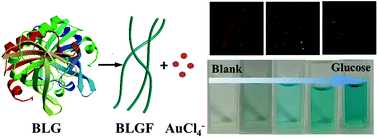β-Lactoglobulin amyloid fibril-templated gold nanoclusters for cellular multicolor fluorescence imaging and colorimetric blood glucose assay†
Abstract
β-Lactoglobulin amyloid fibril (BLGF)-capped gold nanoclusters (Au NCs) with red, green and blue emissions were fabricated via pH-dependent reduction strategy. The BLGF-Au NCs exhibited 3.2 times enhancement of fluorescence (λex = 500 nm, λem = 684 nm), a significant 42 nm red shift, a 11.57% quantum yield and a 1.4 μs decay time compared with native β-lactoglobulin (BLG)-stabilized Au NCs. Meanwhile, the multicolor Au NCs were employed for cell imaging via incubation with A549 cells for 14 h. According to the Michaelis–Menten equation, the kinetic parameters of the BLGF-Au NCs showed a lower Km value (66 μmol L−1) for 3,3,5,5-tetramethylbenzidine (TMB) and a higher vmax (3.74 × 10−8 M s−1) for H2O2, which are comparable with other artificial nanoenzymes and natural peroxidases. Based on the highly intrinsic peroxidase-like activity of the BLGF-Au NCs, a colorimetric method was developed for glucose determination with a detection limit of 1.5 μmol L−1 by determining the variation of the absorption at 652 nm, ranging from 5 to 100 μmol L−1. In addition, the glucose assay method also revealed a 101.02 to 104.16% recovery in a real human serum sample.



 Please wait while we load your content...
Please wait while we load your content...